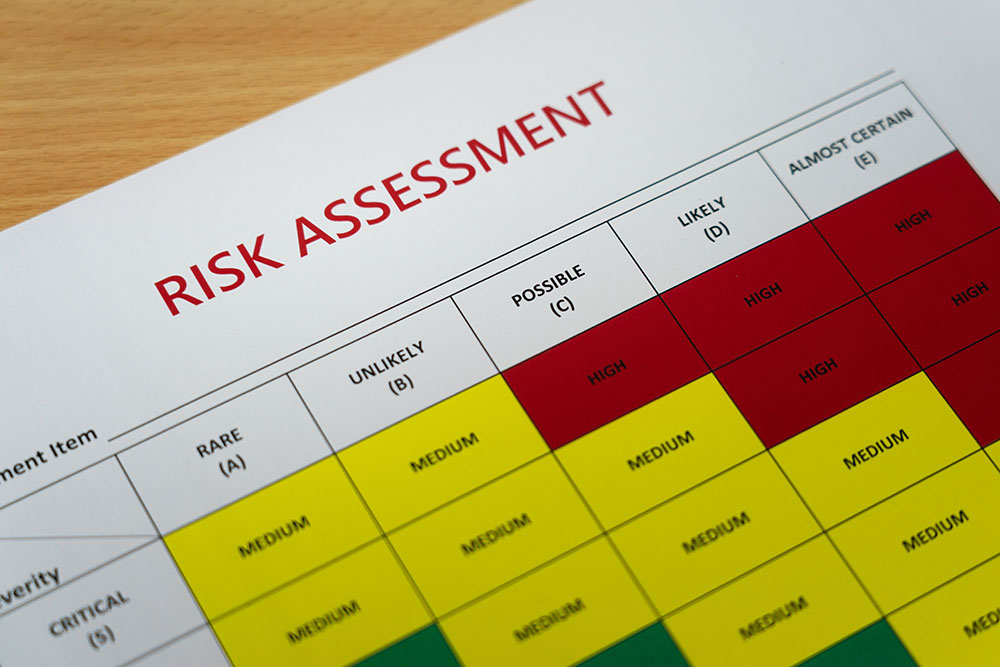Fire Safety Risk Assessment In The Workplace
 CONTENTS
CONTENTS
- How to conduct a fire safety risk assessment
- What to do when a fire breaks out at work
- Who is responsible for fire damage repairs?
- Is it safe to stay in an area where there is fire damage?
- What to do if a fire has damaged your workplace
- Get in touch
Human error is the leading factor that results in workplace fires. This type of negligence is avoidable with risk assessments and training to ensure staff know what to look for. A fire may put your building out of commission and force you to relocate somewhere new.
Here at ICE Cleaning, we offer effective fire clean-up services. Our technicians can restore your office to its original state and scrub the air of any dangerous smoke particles to make your workplace safe again.
Read on to learn more about fire safety risk assessments and how to prevent fires at work.
How to conduct a fire safety risk assessment
A fire risk assessment is an integral part of workplace safety. It is an assessment that looks closely at the property, identifies potential risks, improves fire safety, and implements new fire safety precautions.
According to the UK Government, any individual responsible for fire safety in the workplace must conduct a fire risk assessment regularly. You must keep a written record of your reviews if you employ five or more people. This assessment consists of:
- Identifying potential fire hazards
- Understanding who is at risk
- Removing, reducing, or evaluating the risks
- Recording the findings, providing training, and an emergency plan
- Regular reviews and updates for fire safety
You can mitigate the danger during a fire incident by preparing your workplace with proper fire prevention equipment, training, and appointing an on-site fire marshal. This includes:
- Creating emergency routes and exits
- Installing and testing your fire alarm
- Having fire extinguishers on-site
- Considering exit routes for vulnerable people
- Training new and current employees on fire safety
What to do when a fire breaks out at work
If there is a fire in the workplace, you must remain calm and leave behind your belongings as it hinders the evacuation process. A workplace must have a fire warden or marshal that knows the evacuation plan and follow these steps:
- Use a fire alarm or inform staff of a fire
- Contact 999 for fire emergency services
- Follow your evacuation procedure
- Leave the building through fire exits or routes
- Close any doors behind you to prevent the spread
- Gather at the fire assembly point
- Ensure everyone is accounted for with a roll call
If the fire is small and contained, you can use the appropriate fire extinguishers or blankets to smother the flames. Do not try to fight the fire if it is spreading, or you are not trained.
St. John's Ambulance provides a guide on how to manage fire, casualties, and how to keep yourself safe if you are trapped.
Who is responsible for fire damage repairs?
If you are the property owner, fire damage cleaning will be your financial concern. If you have workplace insurance, they may assist in any costs regarding fire damage.
Because most fires are caused by human error and general negligence, there is equal responsibility across employers and employees to uphold fire safety at work.
If you are an employee that may have been part of the cause of a fire due to negligence, there is a possibility that a legal claim might be raised against you by the property owner. When this happens, you must seek legal counsel from a solicitor to protect yourself.
Ultimately, an employer is legally obligated to conduct fire safety risk assessments, provide a safe environment, implement fire exits, and keep fire safety equipment well-stocked.
Is it safe to stay in an area where there is fire damage?
When there is fire damage in an office, there will be invisible risks present that you might not notice until it is too late.
A lingering smell of smoke is a red flag for danger, as this indicates the presence of smoke particles. These fine particles contain dangerous materials like tar, asbestos, and other chemicals.
The building may also be a structural hazard if the fire impacted the walls, floor, and ceiling. It is unsafe to continue working in a building where a fire occurred.
Fire damage cleaning services will likely include fire smoke odour removal to eradicate any possibility of inhaling airborne toxins.
What to do if a fire has damaged your workplace
Regardless of the scale of a fire, you must contact fire cleaning services and not clean it yourself. There will be hazards that could lead to long-lasting ailments that may affect your respiratory system. Instead, what you should do is:
- Collect evidence of everything destroyed by the fire
- Contact an insurance provider if you have one
- Secure the premises
- Ensure gas, water, and electricity are switched off
- Ventilate the property by letting air circulate inside
- Contact fire restoration services
Get in touch
Our expert cleaners can provide thorough fire cleaning and smoke odour removal services. They will neutralise the air and remove any trace of soot from the property, preventing any long-term damage from remaining.
If you want to learn more about our fire damage services, contact our support team at 0208 066 0360 or enquiries@icecleaning.co.uk. We are available nationwide for emergency cleaning and can be on-site within a few hours.

Speak with me today,
I’m here to help
By asking you a few questions either via phone or email I can immediately provide a realistic estimation of the cost.
You’re in good company. We’ve cleaned for the following commercial clients… View all

Why choose us?
- Cater to a wide variety of cleaning situations
- Nationwide coverage, available 24/7
- Cater to commercial and domestic clients
- Free survey provided prior to quotation
- Emergency response team
- Offer a bespoke service designed to suit all your needs
- All technicians hold professional health and safety qualifications, including BICSc, IOSH, Dewpoint Professional & Safe Contractor
We’re fully accredited
We place best practise, professional expertise and health and safety at the core of our business. We’re fully compliant with all legal obligations. You can view a list of our accreditations below, or visit our Health & Safety page for more information.











-RGB-small.1707319151.jpg)




















